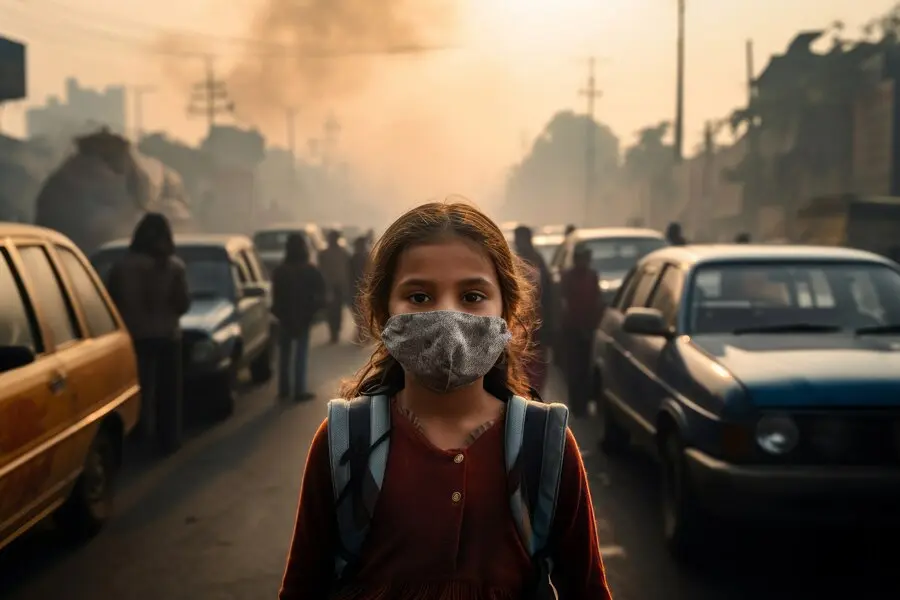Climate Journalism
Delhi Chokes And How Due To Years Of Lethargic “Sub Chalta Hai” Attitude. Why GRAP Alone Won’t Fix Our Poisoned Air
Published
11 months agoon

Let’s be honest, Delhi is suffocating—quite literally. Each winter, as temperatures drop and the air grows heavier, a thick, toxic blanket of smog descends upon the city, seeping into our lungs, our homes, our lives. In this unforgiving haze, it’s not just the skyline we lose; we lose the very air we breathe, and perhaps a bit of hope too.
This week, as the season’s first chill rolled in, Delhi’s air quality plummeted once more into the “severe” category, with AQI levels crossing the 400-mark in many areas. Fine particulate matter (PM 2.5) reached over 50 times the safe level recommended by the World Health Organization.
Imagine trying to breathe through a damp, smoke-filled rag, and you’ve got an idea of what daily life is like in Delhi’s toxic atmosphere.
Year after year, the reasons remain largely the same. Dropping temperatures trap pollutants in the air, while smoke from stubble burning, vehicle emissions, construction dust, and factory exhausts linger, creating a poisonous cocktail. And so, come November, we’re reminded of just how fragile Delhi’s ecosystem is, stretched thin between industrial expansion and the reluctance to address the root of our air pollution.
A Slow, Visible Death
Satellite images from NASA recently showed the expanse of this pollution—stretching from northern India into Pakistan. From space, the problem is clear, but on the ground, it’s clearer still.
According to a study published in The Lancet, 7.2% of daily deaths in Delhi can be attributed to air pollution, with long-term exposure linked to respiratory diseases, cardiovascular issues, and developmental delays in children.
Local media reports a rise in complaints of eye irritation, coughing, and difficulty breathing.
In a recent survey by LocalCircles, 81% of families in Delhi and neighboring areas reported at least one member experiencing health issues in the past three weeks alone. Despite the seemingly endless cycle of advisories and temporary fixes, families are forced to turn to cough syrup and air purifiers to get through their days.

GRAP— A Band-Aid on a Bullet Wound?
This year, the Commission for Air Quality Management (CAQM) responded by activating Stage III of the Graded Response Action Plan (GRAP), an emergency measure designed to tackle severe air pollution in Delhi and surrounding areas.
But what exactly is GRAP?
GRAP is a set of staged, emergency measures designed to be activated as pollution levels worsen. Here’s how it works:
Stage I (AQI 201-300): This stage targets the initial rise in pollution with measures like restricting polluting vehicles, enforcing dust mitigation at construction sites, and initiating automated road cleaning.
Stage II (AQI 301-400): At this level, road sweeping and water sprinkling are intensified, while public transportation services are ramped up to reduce the reliance on personal vehicles.
Stage III (AQI 401-450): When the air reaches this threshold, the city is on red alert. All non-essential construction and demolition work is halted. A ban is imposed on BS-III petrol and BC-IV diesel vehicles, diesel-operated medium goods vehicles that don’t meet BS-III standards, interstate buses entering Delhi from NCR, and several industrial activities.
Stage IV (AQI > 450): In this dire scenario, the city halts most truck traffic, construction work, and reduces office attendance to 50% to limit travel and emissions.
While these are serious restrictions, GRAP is ultimately reactive, meaning it only steps in after pollution has reached a crisis point. This year, the AQI surged past 300 as early as October, forcing the first wave of GRAP measures to be implemented in Delhi and NCR.
Now, just for our understanding, let us examine what is banned and what’s allowed in Stage III of GRAP?
a) Bans on Construction and Demolition: All non-essential construction and demolition work halts, though projects for national security, healthcare, and essential public infrastructure continue.
b) Vehicle Restrictions: BS-III petrol and BS-IV diesel vehicles face bans, alongside diesel-operated medium goods vehicles, except those carrying essential goods. Interstate buses entering Delhi are stopped, as are vehicles carrying construction materials on unpaved roads.
c) Industrial Activities: Stone crushers, certain welding activities, and industrial operations that don’t meet approved fuel standards are all banned across NCR.
d) For permitted activities, some exceptions exist for essential infrastructure projects like metro rail, hospitals, highways, and sanitation efforts. Diesel generators may run only for emergencies, and minor welding for mechanical work is permitted. GRAP Stage III also promotes mechanized road cleaning and off-peak travel incentives to lessen road congestion.
But these limitations only raise the question— are they enough? Or is it simply too late by the time these stages are enforced?

Delhi’s “Sub Chalta Hai” Attitude: How Did We Get Here?
Delhi’s pollution isn’t just the product of crop burning or seasonal shifts—it’s the result of years of negligence and a “sub chalta hai” (it’s fine) mindset that has allowed environmental regulations to go ignored and unchecked.
The result, Delhi has grown into one of the world’s most polluted capitals, and IQAir ranks India as the third-most polluted country globally, trailing only Bangladesh and Pakistan.
Experts argue that Delhi’s woes stem from rapid industrialization, weak enforcement of environmental laws, and unchecked urban development. Factories evade pollution controls, construction projects operate without dust mitigation, and the vehicle count continues to swell. Local sources contribute to over 30% of the city’s pollution, with neighboring NCR areas adding nearly 35% more.
Despite the “severe” pollution, the collective will to address the problem at its root remains weak.
Can We Clear Delhi Air?
If GRAP has shown us anything, it’s that reactive measures alone won’t save Delhi from this environmental catastrophe. To clear Delhi’s air, we need more than just emergency responses; we need a culture shift. The “sub chalta hai” attitude has to give way to a proactive, preventative approach, driven by the recognition that clean air isn’t a luxury but a basic right.
While GRAP is essential as an emergency tool, it’s a patchwork solution that can’t substitute for comprehensive, year-round policies.
Here’s what Delhi needs:
a) Stricter and Consistent Enforcement: GRAP measures, while useful in emergencies, should be backed by year-round, strict enforcement of pollution laws for industries, vehicles, and construction. Without this commitment, even the most stringent GRAP stage becomes a temporary fix.
b) Sustainable Urban Planning: Delhi requires long-term urban planning that includes green spaces, sustainable building practices, and well-maintained roads to reduce dust and vehicle congestion.
c) Crop Residue Solutions: Rather than banning stubble burning outright, providing farmers with affordable, eco-friendly alternatives could help curb one of the biggest seasonal pollution contributors.
d) Public Awareness and Accountability: Residents and authorities must both take ownership of the pollution problem. Regular monitoring, stricter penalties for violations, and public awareness campaigns can help create a culture of environmental responsibility.
The Final Words—The Fight for Breath Must Begin Now
Every winter, we wait with bated breath (quite literally) for the air quality to improve. But how many winters will it take before we truly acknowledge that a crisis of this scale can’t be solved by temporary, reactive measures?
Delhi’s pollution problem is not just a health crisis; it’s a wake-up call. To fix it, we must look beyond seasonal measures like GRAP and instead address the deeper, systemic issues that have led us here.
It’s time to shed the “sub chalta hai” attitude and breathe new life—cleaner, healthier life—into our approach to managing Delhi’s air quality, and India’s as a whole, to lift the smog that hangs over this city and many more, season after season.
You may like
-


7.1 Magnitude Earthquake Devastates Tibet, Tremors Felt In Nepal. Are We Entering The Himalayan Quake Cycle Of 600 Years And Could Bigger Earthquakes Follow, What About India?
-


Farmers Protest, A Renewed Push Toward Delhi. How Authentic And Justified Are The Protesting Farmers Angst?
-


Why Are Stubble Burning Farmers Not Convinced That Their Act Is A Serious Health Hazard. Looking Deeper The Answers Are Many And Extremely Complicated.
